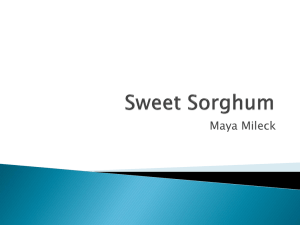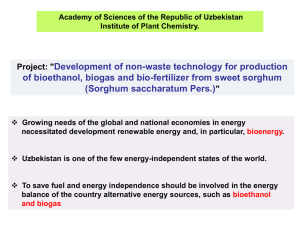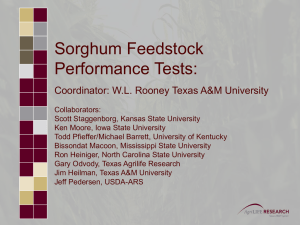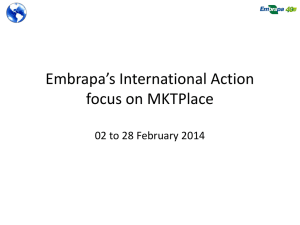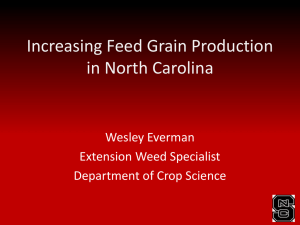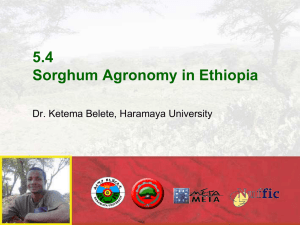Presentation
advertisement
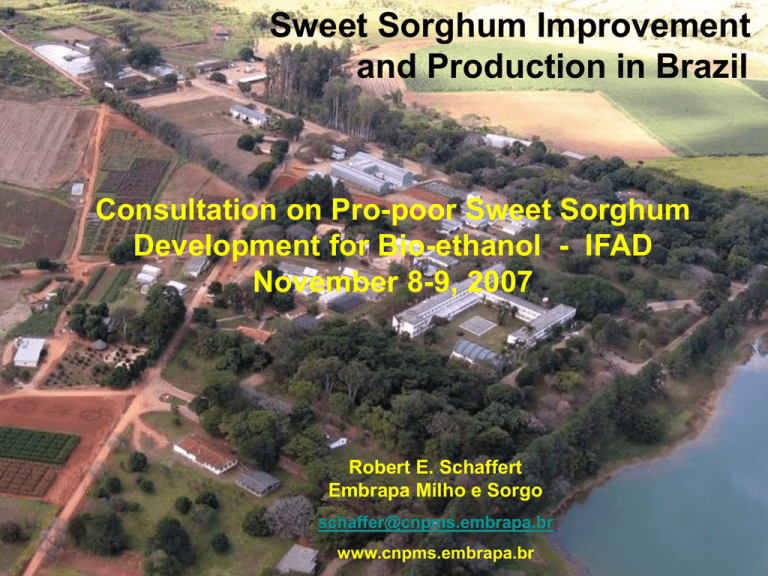
Sweet Sorghum Improvement
and Production in Brazil
Consultation on Pro-poor Sweet Sorghum
Development for Bio-ethanol - IFAD
November 8-9, 2007
Robert E. Schaffert
Embrapa Milho e Sorgo
schaffer@cnpms.embrapa.br
www.cnpms.embrapa.br
In the late 1970´s Brazil initiated a
bio-energy program (Pro-Alcohol)
anticipating an energy crises caused
be a shortage of petroleum to meet
Brazil's fuel needs.
There was a strong incentive to
develop technology for microdistilleries (100L hr-1) and minidistilleries (1000L hr-1)
Embrapa´s sweet sorghum program
was developed to provide raw
material for these distilleries.
Pilot Projects were successfully
developed in the mid-1980’s at Sete
Lagoas, Brasilia, and Pelotas to
process sweet sorghum in microdistilleries.
The potential uses of
sweet sorghum for
food, fiber, fertilizer,
ethanol, and methane
gas production
(Embrapa Maize and Sorghum)
Silage
Advantages of Using Sweet Sorghum vs. Sugarcane
• Sweet sorghum may be harvested 3 – 4 months
after planting
• Sweet sorghum production can be completely
mechanized
• The sweet sorghum crop can be established
from seed
• The grain from sweet sorghum can be used as
food, feed or fuel
• The bagasse from sweet sorghum has a higher
biological value than the bagasse from
sugarcane when used as a forage for animals
• Sweet sorghum is more water use efficient
Sweet
Sorghum
Sugarcane
Microdistillary
Other uses
Integrated
rural energy
system
developed
at Embrapa
Maize
Integrated
Rural
Energy
System
Developed
at and Sorghum 1980
xxxxxxx
Embrapa Maize and Sorghum 1980
x
Development of Sweet Sorghum Cultivars
Breeding priorities depend upon how the product will be used
• Panicles removed for food or feed
Small vs. large panicles
• Juice is extracted from stalks and leaves
Not feasible to separate leaves and stalks
• Juice fermented in micro- and mini-distilleries
Juice extraction less efficient in smaller
distilleries
• Bagasse used for forage or fuel
Starch present in sorghum juice and stalk
Biological value of sweet sorghum bagasse is
greater for sweet sorghum than for sugarcane
• Tillering vs. Non-tillering to control stalk diameter
A Simple Flow Diagram of a Roller Mill Micro-distillery; Used in
Establishing Breeding Priorities at Embrapa Maize and Sorghum
A
- roller mill, B - boiler, C - yeast treatment and distribution tank, D - juice distribution
Xxxxxxxxxxxxxxxxxxxxxxxxxxxxxxxxxxxxxxxxxxxxxxxxxxxxxxxxxxxxxxxx
tanks, E - fermentation tanks, F – beer holding tank, and G - distillation column
X
(Embrapa Maize and Sorghum)
X
Industrial Planning
J
F M
A
M
J
J
A
S
O
N D
Sweet Sorghum
Planting
Harvesting
Sugarcane
Planting
Harvesting
Planting and harvesting periods for sweet sorghum and
sugarcane in Brazil. (Embrapa Maize and Sorghum)
Ratoon Harvest
Irrigation Required
Yield and Quality Goals must be Established
• Minimum Biomass Yield - 40 tha-1
• Minimum Total Sugar Extraction – 80 kg 1t-1 biomass
Considering 60-65% Extraction Efficiency
• Minimum Total Sugar Content in Juice – 12.5%
• Minimum Alcohol Yield – 40L t-1 biomass
Considering:
60 -65% sugar extraction efficiency
90% Fermentation Efficiency
90% Distillation Efficiency or 81% Industrial Efficiency
• Establish minimum parameters for determining Period of
Industrial Utilization (PIU - 80 kg 1t-1 biomass)
• Minimum PIU – 30 days
Total Biomass Production of
Two New Sweet Sorghum
Varieties Developed at
Embrapa for Micro-distilleries
* *
*
*
*
Sweet Sorghum Nomenclature
Average values of brix, total invert sugars, juice extraction, and fiber of selected sweet
sorghum varieties grown at Araras, São Paulo, Brazil in 1981.
Variety
Brix
Total invert sugars
(% juice)
Extraction
(% sorghum stalks)
Fiber
(% sorghum stalk)
Brandes
16.7
14.7
63.2
12.5
Honey
13.0
11.1
73.0
11.6
Sart
14.7
12.4
69.8
14.8
Rio
16.4
14.2
57.6
16.1
MN 1500
14.2
11.4
61.1
18.5
MN 1048
14.1
13.4
56.5
22.0
MN 1030
15.2
10.0
47.6
25.8
MN 4008
10.6
10.5
74.9
12.0
Williams
13.5
12.4
70.5
10.1
MN 4080
14.1
-----
45.7
26.6
Wray
19.3
16.8
67.5
14.8
Theis
16.4
14.2
71.5
14.8
Redlan
10.5
7.4
67.0
13.6
Tx623
10.8
7.0
64.0
13.6
Source: Schaffert and Borgonovi (1980)
Sweet sorghum variety names that begin with the letter or sound or R
are high sucrose types and variety names that begin with other letters
are low sucrose types. Redlan and Tx623 are non-sweet juicy stem
female lines.
RIO
PIU – 32 days
XXX
Xxxxxxxxxxxxxxxxxxxxxxxxxxxxx
The interaction of refractometry xxxxxxxxxxxxxx
xx
Brix and percent total reduced xxxxx
x
sugars in the juice and percent
WRAY
fiber, percent juice extraction,
and percent sugar extraction of
sorghum stalks during the
maturity phase for the varieties
Rio and Wray grown in Brazil,
(Embrapa Maize and Sorghum)
PIU – 58days
Xxxxxxxxxxxxxxxxxxxxxxxxxxxxxxxxxxxxxxxxxxxxxxxx
xx
Zzzz
-1
Brix, Total Sugars, Fiber and Percent Water of
four sweet sorghum cultivars at Embrapa
Maize and Sorghum, Sete Lagoas, Brazil,
1986/87.
Sugar extracted ( Kg 100 Kg biomass)
BR 501 = Brandes, BR 505 = Wray, BR506 and BR507 are new
derived varieties
Brix (% juice))
xxx
Percent fiber of fresh biomass
Total
juice)
Totalsugars
Sugars(%
(%)
BR 505
xxx
Percent water in the biomass
xxxxxxxxxx
Period for Industrial Utilization
Wray 9% Total sugars
Wray 8% Total sugars
xxxx
Wray PUI 32 days
Wray PUE 51 days
PUI 28 days
The interaction of refractometry Brix and percent total invert sugars in the juice
and percent fiber, percent juice extraction, and percent sugar extraction of
sorghum stalks during the maturity phase for the variety Rio grown in Brazil
(Embrapa Maize and sorghum) .
Sugar extraction (%)
Brix, total sugars (%), fiber (%), and juice
extraction (%)
PUI – 35 days
The interaction of refractometry Brix and percent total invert sugars in the juice
and percent fiber, percent juice extraction, and percent sugar extraction of stalks
during the maturity phase for the variety Brandes grown in Brazil (Embrapa Maize
and Sorghum).
PUI 37 days
Sugar extraction (%)
Brix, total sugars (%), fiber (%), and juice
extraction (%)
CMSXS 623 (Brandes Derivative)
The interaction of refractometry BrixDays
andafter
percent
planting total invert sugars in the juice
and
percent of
fiber,
percentBrix
juice
and sugars
percent
sugar
of stalks
The interaction
refractometry
andextraction,
percent total invert
in the
juice extraction
and percent fiber,
percent
during
the maturity
phase
the variety
Brandes
inmaturity
Brazil phase
(Embrapa
juice
extraction,
and percent
sugarfor
extraction
of sorghum
stalks grown
during the
for the Maize
variety
CMSXS
623 grown in Brazil (Embrapa Maize and sorghum).
and Sorghum).
PUI 54 days
The interaction
of refractometry Brix
Brix and
percent
total invert
in the
juice and
The interaction
of refractometry
and
percent
totalsugars
invert
sugars
inpercent
the juice
fiber, percent juice extraction, and percent sugar extraction of sorghum stalks during the
and percent
fiber,
percent
juiceWray
extraction,
and(Embrapa
percent
sugar
extraction
of stalks
maturity
phase
for the variety
grown in Brazil
Maize
and sorghum)
.
during the maturity phase for the variety Brandes grown in Brazil (Embrapa Maize
and Sorghum).
Biomass and Alcohol Production of two new Cultivars, BR506 and
BR507, Compared to Brandes and Wray
Alcohol Yield
Cultivar
Biomass
Production
(t ha-1)
Extracted Sugar Yield
(kg 100 kg-1)
Brandes
Wray
BR506
BR507
47.4
44.6
48.8
52.0
Embrapa Maize and Sorghum 1986/87
7.2
10.9
9.7
9.6
(t ha-1)
3.4
4.6
4.7
5.0
Ideal
(L ha-1)
81%
Efficient
(L ha-1)
2208
2946
3062
3231
1788
2386
2481
2617
Relative
(% Wray)
75
100
104
110
Current Plant Breeding Strategies and Priorities
• Develop sweet sorghum 3 dwarf A and B lines (female) to be used
in hybrid development and production
- Identify molecular markers for juicy stem and sweet juice
- Incorporate genes for multiple stress (biotic and abiotic)
resistance
• Evaluate existing new sweet sorghum cultivars (approx. 50) and
develop new sweet sorghum R lines (male) to be used in
hybrid development and production
- Incorporate genes for multiple stress (biotic and
abiotic) resistance
• Identify molecular markers for tillering - Non-tillering desired to be
able to control stalk diameter with plant population (better
extraction with large stem diameter)
• Develop transgenic sweet sorghum with sucrose isomerase gene
(SI), a gene that regulates the transformation of sucrose to
isomaltulose and thus can increase the sink capacity of sugar
storage (Wu and Birch, Plant Biotechnology Journal (2007) 5
(pp109-117)
Plant Breeding Strategies and Priorities (cont.)
• Develop high yielding biomass cultivars for cellulose conversion
to bio-energy
- Identify molecular markers for maturity genes Ma5 and Ma6
to be able to develop photosensitive (PS) sorghum biomass
hybrids
Ma5Ma5ma6ma6 is photo-insensitive (PIS) and flowers in
approximately 60 days regardless of day length.
ma5ma5Ma6Ma6 is photo-insensitive and flowers in approximately 60
days regardless of day length.
The hybrid between these genotypes, Ma5ma5Ma6ma6 is photosensitive (PS) and floral initiation is only induced with day lengths
less than 12h and 20min.
This can be useful in both sweet sorghum and biomass sorghum in
locations farther from the equator where there is more variation in
day lengths (McCollum et al. reported average yield increases of 25%
of PS hybrids over PIS hybrids at Amarillo, Texas).
Plant Breeding Strategies and Priorities (cont.)
• Develop high yielding biomass cultivars for cellulose conversion
to bio-energy
- Identify molecular markers for brown midrib low lignin
genes genes brm-6 and brm-12
Homozygous brm-6 hybrids and brm-12 hybrids have
been reported to reduce lignin content in sorghum
biomass by 50%
Production Cost of alcohol from sweet sorghum in
Brazil in micro-distilleries in November, 1980.
Item
US$
Production Cost /ha
320.00
Cost/t stalks (30 t/ha)
10.67
Cost/t stalks (40 t/ha)
8.00
Cost/t alcohol (45 liter/t and 40 t/ha)
0.22
Cost/t alcohol (59 liter/t and 40 t/ha)
0.20
Cost/t alcohol (68 liter/t and 40 t/ha)
0.17
Source: Embrapa Maize and Sorghum, Sete Lagoas, MG, Brazil.
The price of ethanol today (November 5, 2007) is about US$ 0.35 L-1 at the
distillery gate and US$ 0.75 to 0.90 at the pump, depending on the distance
from distilleries
Incorporação de Tolerância ao Al em Cultivares de Sorgo Elite
e Desenvolvimento de Linhagens Isogênicos
Seleção p/ Tolerância ao Al em Solução Nutritiva
BR 007B SC 283
Retrocruzamento Assistido para Desenvolver
Linhagens de Sorgo com Tolerância ao Al Tóxico.
Linhagem
Recorrente
Susceptível x
Cross
F1
BC1
BC1F1
BC2
BC2F1
.
.
.
BC4F1
BC4F2
Tol x Suc F3 Progenies
tt
tt
½ Tt
tt
½ Tt
½ Tt
¼ TT ½ Tt
x
Tt
x
Fonte
Tolerante
TT
Tt
(½ tt eliminado em solução nutritiva)
x
Tt
(½ tt eliminado em solução nutritiva)
(½ tt eliminado em solução nutritiva)
(½ tt eliminado em solução nutritiva)
BC4F3 100% TT and 97% Igual ao pai recorrente
Estamos incorporando o gene para tolerância ao Al em nossas
linhagens elites em seis gerações usando a casa de vegetação em
dois anos. O parâmetro usado é crescimento de raiz em solução
nutritiva por sete dias.
Usando este tecnologia estamos empilhando genes úteis em genótipos
com tolerância ao estresse múltiplo.
Estamos com ensaios no campo com três níveis de Al para quantificar
o efeito dos genes para tolerância ao Al tóxico na produtividade e
COELHO & SCHAFFERT, 2005
Intra-Specific Diversity for Al Tolerance in Sorghum
• SC283 and SC566 rely on the same locus AltSB for Al tolerance
• Genetic basis apparently narrow
• 8 different Al tolerant sources x BR012
• Inheritance study and linkage analysis to markers in the AltSB region
• SSR-based phylogenetic analysis
RRG - +Al/-Al
Genotypes
{11}
{20}
{27}
{39}
BR007B
45
21
16
9
BR012R
87
52
35
20
IS8577
113
78
55
29
SC112-14
105
82
45
18
SC549
100
91
74
50
3DX571-1-1-9-D
116
95
70
52
9DX9-11
99
82
70
63
5DX61-6-2
125
113
96
55
SC175-14
104
100
84
78
CMSXS225R
94
109
109
82
SC566-14
124
103
105
98
SC283
103
114
112
107
• Al tolerance gene diversity for
pyramidation via breeding
• Stronger alleles of AltSB
• Different haplotypes at AltSB for
candidate gene validation
• Foundation for future association
tests
Desenvolvimento de Sorgo Mais Eficiente na Aquisição de P
•
•
A identificação e conhecimento
das mudanças no rhizosfero,
mecanismos de aquisição e
utilização de P facilitarão a
manipulação destes parâmetros.
+P
-P
SC283
BR 005R (EN)
+P
-P
Tol
Baixa P
Alta P
Al
t/ha
t/ha
(%)
BR 007B
S
1.95
4.86
2.49
IR
SC283
T
2.66
3.29
1.23
EN
BR 005R
S
2.74
3.51
1.28
EN
2.16
3.60
1.43
Médio Ensaio
•
BR007B (IR)
Grão
Pedigree
Não existe conhecimento de
parâmetros nos cereais
correlacionados a eficiência de
aquisição/utilização de P.
Xxxx
Grão
xx
Tem a necessidade de
identificar ou desenvolver
genótipos com diferenças
na habilidade de adquirir
e utilizar P eficientemente
Resposta
Classe
ao P
Plantas de Sorgo com
xxx
21 Dias em Rhizobox
SC 283 (EN)
+P
-P
•
BR007B
BR007
Utilizando condições de
campo, solução nutritiva,
e casa de vegetação,
identificamos genótipos
de sorgo contrastantes
para aquisição e resposta
ao P
SC 283
Pelos de raízes dos genótipos SC283 (eficiente) e
BR007 (responsivo) em estresse de P
+P
-P
Produção diferencial de Sorgoleone
em Sorgo
SC 283 – SEM FÓSFORO
Sorgoleone Production by Various Sorghum Genotypesa
Root Fresh
Wt
(RFW) (g)
Sorgoleone
mg
Sorgoleone
per unit RFW
(mg/g)
% Purity
RTx433
0.15
0.10
0.67
91.8
RTx7078
0.15
1.80
12.00
98.7
RTx430
0.08
0.30
3.75
94.9
B Redlan
0.15
2.67
17.80
80.2
B Wheatland
0.33
0.83
2.50
78.3
Sorghum
Genotype
BR 007 B – SEM FÓSFORO
a- three replicates of 25 seedlings each Fonte: Chandrashekhar I, et al.; J. Agric. Food Chem. 1996,
44, 1343−1347
Photomicrograph of Sorghum bicolor
roots showing a sorgoleone-rich oily
exudate secreted from the root hairs
(Bar=80 μm) and b closer view of a root
hair with sorgoleone exuding at the tip
(Bar=15 μm). Sorgoleone-rich oil from tip
of root hairs also exudes from secondary
roots originating either from c roots
(Bar=125 μm) or d stem (adventitious
roots) (Bar=350 μm)
Fonte: F.E. Dayan, USDA-ARS Natural Products
Utilization Research Unit, P.O. Box 8048, University,
MS 38677, USA
Desenvolvimento de Cultivares de Sorgo Forrageiro de Alta Qualidade (bmr6 bmr6)
Linhagens A e B bmr6
A/BTx 635
A/B BR007
A/B CMSXS205
A/B CMSXS206
A/B BR008
A/B CMSXS156
A/B CMSXS 157
Hibrido Sorgo
Forrageiro de Corte
Tx635bmr6A
x
Tx2784bmr6R
Linhagens R bmr6
RTx2784
RTx2785
CMSXS912
CMSXS225
Desenvolvimento de
novas linhagens bmr6 A/B
e R com tolerância ao
múltiplo estresse
Hibrido Sorgo
Forrageiro de Corte
Tx635bmr6A
x
Tx2785bmr6R
Final Remarks
• Embrapa has a relative large number (50 -60) of sweet sorghum varieties
available for characterization for quality and utilization in developing
experimental hybrids.
• The variety BR501 (Brandes) is tolerant to Al toxicity and is the restorer
parent in two commercial forage sorghum hybrids. Brandes probably
was selected 25 years ago because it was tolerant to Al toxicity.
• Brandes was successfully used in two pilot sweet sorghum distilleries in
Jundiai, SP and Pelotus, RS.
• The proof of concept of sweet sorghum as a biofuel source has been
determined. The next step is an economic evaluation for
competitiveness with other available raw materials.
• Embrapa is currently evaluating the return to an active research and
development program with sweet sorghum as a source for bio-fuels.
Thank You
Robert Schaffert
Embrapa Maize and Sorghum
reschaffert@hotmail.com
schaffer@cnpms.embrapa.br
Tel: +55-31-3779-1076
Hibrido Sorgo
Forrageiro de Corte
Tx635bmr6A
x
Tx2785bmr6R
Fiber
Increases and
Juice
Extraction
Decreases
with Time
Brandes
Percent fiber and juive extraction of cultivar Brandes at Araras, CNPMS/EMBRAPA,
1981 and 1982 (Schaffert et al. 1986).
Wray
Percent fiber and juive extraction of cultivar Wray at Araras, CNPMS/EMBRAPA,
1981 and 1982 (Schaffert et al. 1986).
Juice Extraction Varies Between Cultivars
Percent juice extraction of four sweet sorghum cultivars at CNPMS/EMBRAPA, Sete Lagoas, Brazil,
1986/87, BR 501 = Brandes; BR 505 = Wray.
Agricultural and Industrial yields of sweet sorghum in Brazil.
Component
Stalks
Grain
Total
Agricultural Yield
Alcohol yield
(t/ha)
(liter/t)
(liter/ha per harvest)
Range
22 - 66
55 - 85
1210 - 5610
Average
37.7
70
2639
Range
1.4 - 6.6
310 - 370
434 - 2442
Average
2.2
340
748
Range
1644 - 8052
Average
3387
Source: Schaffert and Borgonovi (1980)
Mean yield of stalk, fermentable sugar, alcohol, fresh
biomass and seed of sweet sorghum in experiments at the Beijing
Botanical Garden
Cultivar
Theis
M-81E
Wray
Keller
Brandes
Rio
95
89
76
76
62
52
Fermentable sugar
(t/ha)
10.6
9.6
10.3
10.5
6.4
6.2
Alcohol (l/ha)
6 159
5 607
5 981
6 131
3 696
3 617
125
128
106
107
89
82
6 674
6 213
1 426
1 960
3 500
2 866
Stalk (kg/ha)
Fresh material (t/ha)
Seed (kg/ha)
Comparison of juice between sweet sorghum and sugarcane in Brazil.
Sweet Sorghum
Trait
Literature
National Trials
Sugarcane (São Paulo averages)
Juice extraction (%)
350 - 600
500 - 700
600 - 800
Retractometer Brix
16 - 20
14 - 20.
18 -21
Sucrose (% juice)
10 -15
8 - 16.
15 - 18
1-4
0.7 - 7.3
0.2 - 1.5
14 - 20
14 - 18
16 - 19
Invert sugars (% juice)
Total invert sugars (% juice)
Source: Schaffert and Borgonovi (1980)
Sucrose vs. Total sugars
Maximum dry matter production and maximum growth rates of several crops.
Dry Matter Production
Maturity
Average Growth rate
Maximum growth rate
(t/ha)
(days)
(gm/m2 per day)
(gm/m2 per day)
Napier
106
365
26
-----
Sugarcane
70
365
18
38
sugarbeet
47
300
14
31
Forage sorghum
30
120
22
-----
Forage sorghum
43
210
19
-----
Sudangrass
33
160
18
51
Alfafa
36
250
13
23
Bermudagrass
35
230
14
20
44 - 74
300
15 - 22
28
Crop
Alga
Source: Loomis and Willian (1963)
National Forage Sorghum Trial - 1986/87 Embrapa Maize and Sorghum
Location and Date of Planting
Cultivar
Linhares
Goiânia
Capinópolis
Ituiutaba
Taquari
Cruz Alta
S.J. dos
Campos
ES
GO
MG
MG
RS
RS
SP
Mean
04.12.86
09.01.87
BR601
(%)
10.12.86
29.12.86
01.12.86
16.12.86
12.12.86
Mean
Relative
Biomass Production (t/ha wet weight)
BR506 (V)
46.3
55.2
43.3
55.5
41.9
59.3
50.8
52.8
109
BR507 (V)
41.1
53.2
43.7
47.3
39.8
55.7
68.1
49.5
102
BR601(H)
47.3
44.1
41.1
54.3
47.6
55.1
66.0
48.6
100
BR126* (MV)
19.1
39.6
36.6
35.0
25.5
32.3
36.0
32.1
66
Biomass Production (t/ha dry weight)
BR506 (V)
14.4
11.6
10.2
NA
13.4
17.7
18.7
14.6
108
BR507 (V)
15.6
12.4
11.7
NA
14.1
18.9
18.2
15.6
115
BR601(H)
12.0
14.6
12.7
NA
14.8
18.3
14.3
13.5
100
BR126* (MV)
7.4
16.9
15.4
NA
9.9
11.8
12.7
11.5
85
* Forage Maize Variety
*
*
**
*
Percent total sugar (Juice)
Wray
Rio
Brandes
CMSXS623
Days after planting
The differences between four cultivars grown in Brazil for total invert sugars
of the juice during the maturity phase of production (Embrapa Maize and
sorghum).
Percent fiber and juice extraction
Rio
CMSXS623
Wray
Brandes
Brandes
CMSXS623
Wray
Rio
a
Days after planting
The differences between four cultivars grown in Brazil for juice extraction
and fiber content of the stalks during the maturity phase of production
(Embrapa Maize and Sorghum).
Average yields:
Stalks
Leaves, peduuncle and
heads
Tons/ha
32.9
13.6
46.5
Estimated approximate composition of sweet sorghum sugar varieties in
the United States (Nathan, 1978)
Average yields:
Stalks
Leaves, peduncle
and heads
Tonnes/ha
47.4
19.3
66.7
total
Estimated approximate composition of sweet sorghum syrup varieties in
the United States (Nathan, 1978)
